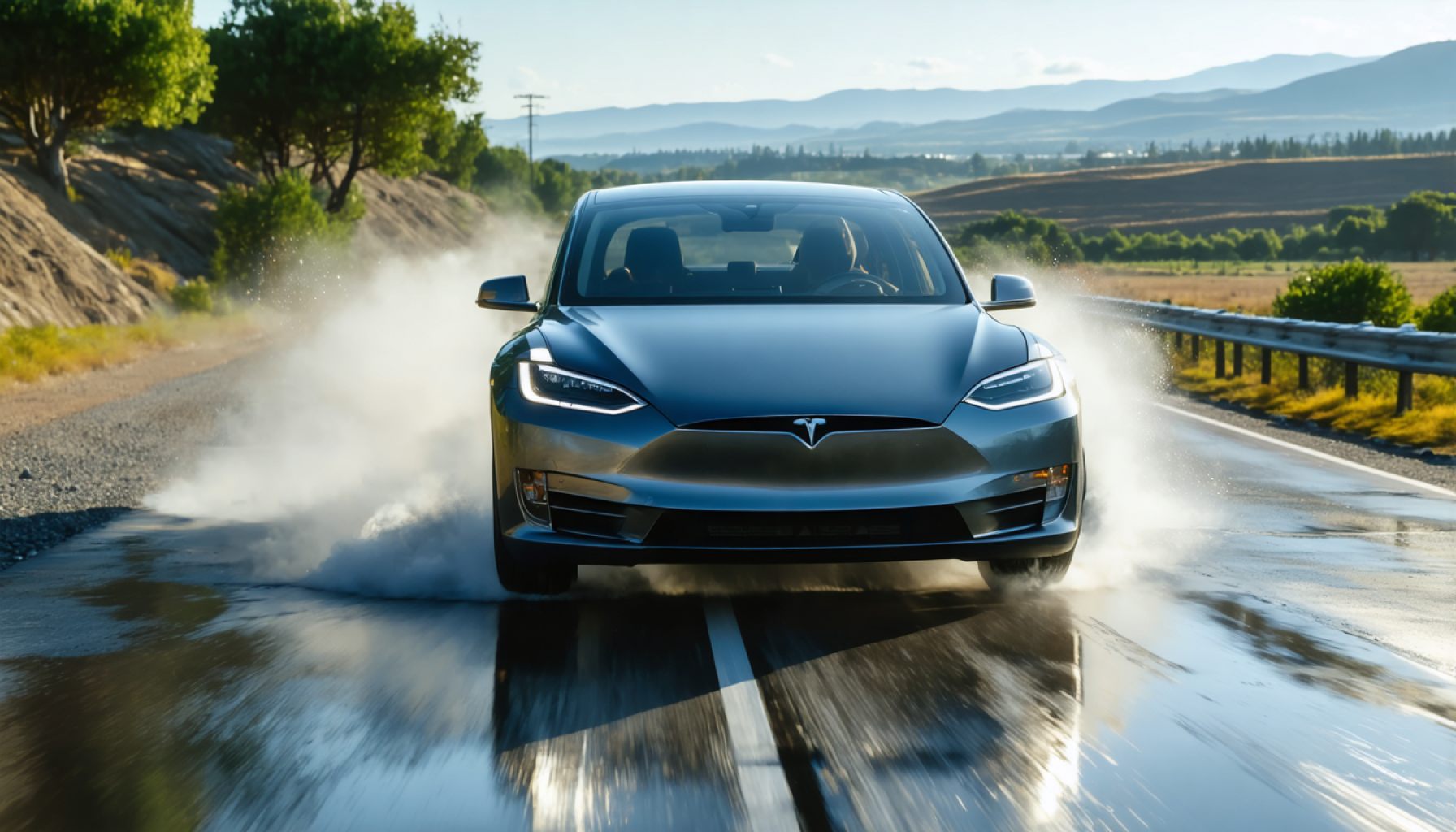- Tesla’s first-quarter vehicle deliveries are estimated at 346,000, below the anticipated 398,000, affecting short-term investor sentiment.
- The production halt for a refreshed Model Y and anticipation of a more affordable model have temporarily affected sales.
- Regional delivery declines include a 5.4% drop in the U.S., a 48% drop in China, and a 20% decrease in Europe.
- RBC maintains an ‘outperform’ rating for Tesla with a $320 price target, emphasizing faith in the company’s long-term potential.
- Tesla remains a key player in the EV sector, with innovation in energy solutions, software, and AI, despite a 36% share decline over three months.
Tesla, a name synonymous with innovation, stands at a crossroads as financial markets react to whispers of underwhelming first-quarter vehicle deliveries. A heartbeat ago, Tesla’s pioneering spirit catapulted it into the position of a market darling. Now, investors are grappling with the tension between short-term setbacks and long-term potential.
RBC Capital Markets recently dropped a prediction that sent ripples through the investment community. They estimate Tesla’s first-quarter deliveries to land at 346,000 vehicles, starkly below the anticipated 398,000. This shortfall, a divergence from some market analysts’ expectations, appears driven by Tesla’s strategic pause—halting Model Y production to make way for a refreshed variant. This decision, while forward-thinking, may have temporarily cooled buyer enthusiasm, as keen purchasers await the arrival of the newly minted vehicle.
In a curious twist, the anticipation of a more affordable Tesla model due for release in the second quarter has further contributed to this sales deferral. Buyers, it seems, are choosing patience over immediate gratification, holding out for more wallet-friendly options.
The granular breakdown from RBC reveals regional delivery declines: a 5.4% dip in the U.S., a staggering 48% drop in China, and a nearly 20% decrease in Europe. Such numbers highlight the varied challenges and opportunities Tesla faces across different global markets.
Yet, amidst this chiaroscuro of short-term uncertainties, RBC’s confidence in Tesla remains unshaken. Their ‘outperform’ rating, paired with a robust $320 price target, underscores a faith rooted in Tesla’s long-term prospects. Without question, the company’s mastery of the electric vehicle narrative, its innovation in energy solutions, software, and artificial intelligence continues to beckon investors towards a future ripe with potential.
Despite shares cooling off by about 36% over the past three months, a reflection of both delivery anxieties and a shift in investor sentiment, Tesla’s trajectory remains a subject of fascination. The electric vehicle sector’s relentless push toward sustainability offers fertile grounds for Tesla to plant new seeds of growth.
In the end, the tale of Tesla is far from over. With its sights set on reshaping transportation and energy landscapes, this trailblazer stands, even in adversity, as a beacon of what’s possible. Investors, analysts, and auto enthusiasts worldwide watch keenly, awaiting the next chapter in Tesla’s storied journey.
Is Tesla’s Current Setback a Temporary Hurdle or a Sign of Bigger Challenges Ahead?
Overview:
Tesla, a titan in the electric vehicle (EV) industry, finds itself at a critical juncture, with recent news unveiling a dip in first-quarter vehicle deliveries, casting a shadow over its stock performance. Yet, amidst these short-term challenges, Tesla’s long-term potential continues to captivate both investors and enthusiasts. This article delves deeper into the nuances of Tesla’s current situation and explores its implications on the future of the EV market.
New Developments and Features:
1. Model Y Production Pause: Tesla’s strategic decision to halt Model Y production temporarily aims to introduce a refreshed version. This move, while potentially reducing immediate sales, sets the stage for future growth as consumers eagerly await the updated model.
2. Anticipation for a Budget-Friendly Model: Tesla’s rumored release of a more affordable EV in Q2 has caused some buyers to hold off on current purchases. This strategy could expand Tesla’s market reach, attracting a broader demographic.
3. Regional Sales Analysis: The delivery decline varied significantly across regions, with the most pronounced drop seen in China (48%). Several factors contribute to this, including geopolitical tensions and local market competition from Chinese EV manufacturers.
Market Trends and Industry Forecasts:
– EV Industry Growth: Despite Tesla’s recent delivery shortfall, the overall demand for electric vehicles is on the rise globally. Industry analysts predict the global EV market to grow at a CAGR of 21.7% from 2021 to 2030 (Allied Market Research).
– Sustainability Initiatives: Tesla’s commitment to sustainability resonates with the industry’s shift towards greener solutions. Its advancements in battery technology and renewable energy integration remain pivotal to its future success.
Pros and Cons Overview:
– Pros:
– Innovation Leadership: Tesla continues to lead in technology and innovation within the EV market.
– Market Expansion: Plans for new models and expanded markets could position Tesla favorably for long-term growth.
– Cons:
– Short-Term Delivery Issues: Recent production halts and delivery shortfalls may affect quarterly earnings and, subsequently, stock performance.
– Competition: Rising competition from other EV manufacturers, especially in China, poses a significant challenge.
Expert Opinions:
– RBC Capital Markets stands by Tesla with an ‘outperform’ rating and a $320 price target, emphasizing confidence in Tesla’s strategic initiatives and long-term potential despite current setbacks.
Actionable Recommendations:
– For Investors: Consider Tesla as a long-term investment. While short-term setbacks might seem concerning, the company’s innovative edge and market position offer promising growth prospects.
– For Consumers: If considering purchasing a Tesla, evaluate current offerings against upcoming models to make an informed decision based on budget and features.
Conclusion:
Tesla’s current delivery woes highlight the complexities of balancing innovation with market expectations. However, its commitment to advancing EV technology and renewable energy solutions keeps it at the forefront of the industry. For Tesla, the road ahead is paved with both challenges and opportunities, making its journey one to watch closely.
For more insights on electric vehicles and sustainability, visit Tesla.
